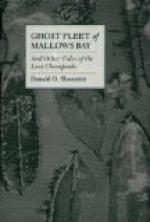Here my companion stopped a minute—and in the pause we could hear the old trees wave very solemnly above us, and a nut, or burr, or sycamore ball, came rattling down the old kirk roof as we stood there in the graves, to startle us the more, and then he said:
“It is just as queer as the tale he told me—the disappearance of that old man. Nobody about here can recognize him from my descriptions. He walked toward the old mill down the Newark road, and the next time I looked up he was gone. The people in the house there think I am flighty in my mind for insisting upon his appearance to me at all.”
“Go on with the tale right here, my flesh-creeping friend,” I said. “It will do us good to feel occasionally solemn.”
* * * * *
“This stone, young man,” said my Quakerly rebuker, in a hard country farmer’s voice; “this stone is the London Tract Ticking Stone. It is the oldest preacher and admonitor in this churchyard. It is older than the graves of any of the known pastors or communicants round about it.
“In the year 1764 the comparative solitude of this region was broken by a large party of chain-bearers, rod-men, axe-men, commissaries, cooks, baggage-carriers, and camp-followers. They had come by order of Lord Baltimore and William Penn, to terminate a long controversy between two great landed proprietors, and they were led by Charles Mason, of the Royal Observatory, at Greenwich, England, and by Jeremiah Dixon, the son of a collier discovered in a coalpit. For three years they continued westward, running their stakes over mountains and streams, like a gypsy camp in appearance, frightening the Indians with their sorcery. But, near this spot, they halted longest, to fix with precision the tangent point, and the point of intersection of three States—the circular head of Delaware, the abutting right angle of Maryland, and the tiny pan-handle of Pennsylvania.
“The people of this region were sparse in number, but of strong, sober, and yet wild characteristics. The long boundary quarrel had made them predatory, and though God-fearing people, they would fight with all their religious intensity for their right in the land and the dominion of their particular province. They suspended their feuds when the surveying battalion came into their broken country, and looked with curious interest upon all that pertained to the distinguished foreign mathematicians. Around their camp of tents and pack-mules, peddlers and preachers called together their motley congregations, and the sound of axes clearing the timber was accompanied by fiddling and haranguing, the fighting of dogs, and the coarse tones of religious or business oratory. It was in the height of the era of the great period of the Dissenters in England, and Methodist, Baptist, and Calvinistic zealots were piercing to the boundaries of English-speaking people, wild forerunners of those organized bands of clergy which were speedily to make our colonies sober-minded, and prepare them for self-government.




